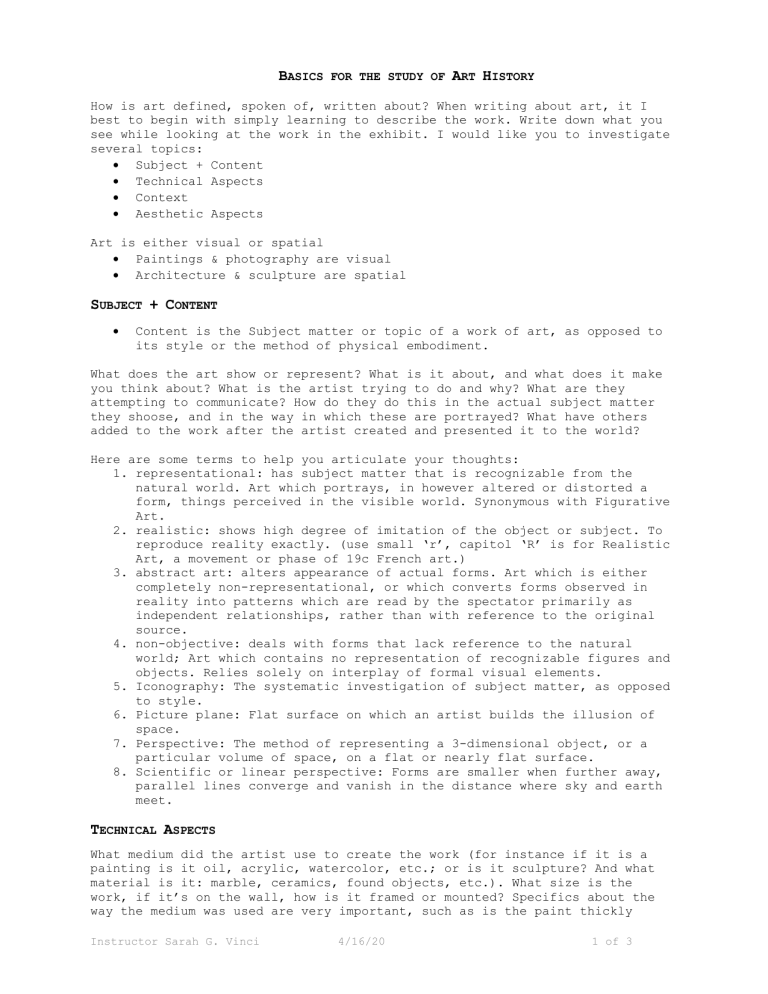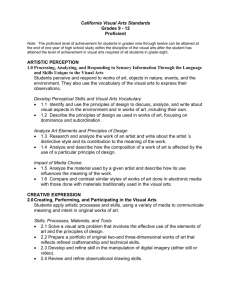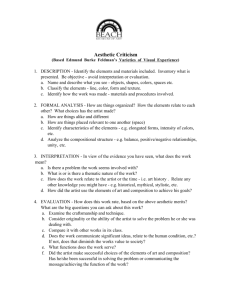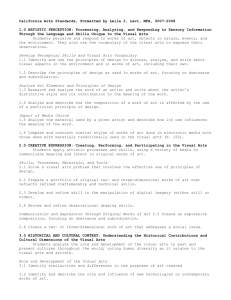basics for the study of art history

B ASICS FOR THE STUDY OF A RT H ISTORY
How is art defined, spoken of, written about? When writing about art, it I best to begin with simply learning to describe the work. Write down what you see while looking at the work in the exhibit. I would like you to investigate several topics:
Subject + Content
Technical Aspects
Context
Aesthetic Aspects
Art is either visual or spatial
Paintings & photography are visual
Architecture & sculpture are spatial
S UBJECT + C ONTENT
Content is the Subject matter or topic of a work of art, as opposed to its style or the method of physical embodiment.
What does the art show or represent? What is it about, and what does it make you think about? What is the artist trying to do and why? What are they attempting to communicate? How do they do this in the actual subject matter they shoose, and in the way in which these are portrayed? What have others added to the work after the artist created and presented it to the world?
Here are some terms to help you articulate your thoughts:
1.
representational: has subject matter that is recognizable from the natural world. Art which portrays, in however altered or distorted a form, things perceived in the visible world. Synonymous with Figurative
Art.
2.
realistic: shows high degree of imitation of the object or subject. To reproduce reality exactly. (use small ‘r’, capitol ‘R’ is for Realistic
Art, a movement or phase of 19c French art.)
3.
abstract art: alters appearance of actual forms. Art which is either completely non-representational, or which converts forms observed in reality into patterns which are read by the spectator primarily as independent relationships, rather than with reference to the original source.
4.
non-objective: deals with forms that lack reference to the natural world; Art which contains no representation of recognizable figures and objects. Relies solely on interplay of formal visual elements.
5.
Iconography: The systematic investigation of subject matter, as opposed to style.
6.
Picture plane: Flat surface on which an artist builds the illusion of space.
7.
Perspective: The method of representing a 3-dimensional object, or a particular volume of space, on a flat or nearly flat surface.
8.
Scientific or linear perspective: Forms are smaller when further away, parallel lines converge and vanish in the distance where sky and earth meet.
T ECHNICAL A SPECTS
What medium did the artist use to create the work (for instance if it is a painting is it oil, acrylic, watercolor, etc.; or is it sculpture? And what material is it: marble, ceramics, found objects, etc.). What size is the work, if it’s on the wall, how is it framed or mounted? Specifics about the way the medium was used are very important, such as is the paint thickly
Instructor Sarah G. Vinci 4/16/20 1 of 3
applied, are the brushstrokes obvious or hidden? Pay attention to the surface in this area of investigation.
Here are some terms to help you:
1.
Line: defines outlines, contours a form, delineates shape
2.
Shape: 2-demensional form, an area on a flat plane
3.
Mass: 3-dimensional, occupying a volume of space. Ie. Free standing sculpture
4.
Texture: actual surface quality, brushstrokes
5.
Color is an effect on our brains of light waves of differing wave lengths reflected off objects. Source light is white light. Light bounces off objects giving optical illusions of color. a.
Hue: essential color, ie. Sun & rainbow. White light (sun) passes through drops of water in air, raindrops become crystal prism separating wavelengths of light into hues b.
Intensity: degree of hues purity. The closer a color is to original rainbow, or spectrum hue, the higher the intensity and brighter appearance. c.
Value: degree of lightness & darkness i.
Tint: color lighter than hues normal value
1.
Example: apple green is tint of pure green ii.
Shade: color darker
1.
Example: forest green is shade of pure green
A ESTHETIC A SPECTS
Aesthetics: The philosophy of the beautiful in art.
The visual or aesthetic aspects of the work include which pieces are attractive to you and why? How are flat or three-dimensional works visually constructed? Are there visual or compositional similarities or differences about them? What is the arrangement of the various elements in the work? In flat work, pay attention to the framing, where does the image end? Pay attention to the point of view, where is the viewer in relation to the image: close or far, above or below, etc. Do the works have some sort of visual style, and might you describe that?
Here are some terms:
1.
Composition: How formal elements are put together. The combination of elements in a painting or other work of art so that they seem satisfactory to the artist
2.
Form: what we see, what is visible.
3.
Style: the combination of distinguishing characteristics, that define a work of art as the creation of a certain artist, or time, or place.
C ONTEXT
When was the work created? What influenced the artist, in terms of culture, history, other artists. What stage of their life or career was the work created? Where did the creator live and work, and did that geographic location influence the work? How does this piece affect other works of art made by other artists later in time, or was this artist an influence on artists to come?
••••
"He who loves practice without theory is like the sailor who boards ship without a rudder and compass and never knows where he may cast."
Leonardo da Vinci (1452-1519)
Other helpful terms:
Instructor Sarah G. Vinci 4/16/20 2 of 3
Art Criticism: The description, analysis, evaluation, interpretation, and judgment of works of art.
Theory: A set of abstract rules, ideas, and principles that explain a particular subject, as opposed to actual practice. Or, an unproved assumption, a hypothesis or conjecture assumed for the sake of argument.
There are several stages to critical analysis:
1.
Initial reaction to a work.
2.
Description – identifying subject matter and / or elements of art in a work.
3.
Analysis – identifying order in a work – how principles of art have been used to arrange the elements of art in a work.
4.
Interpretation – the artist's expression / communication of feelings, moods, and ideas in a work.
5.
Evaluation – assessing the meaning and artistic merit in a work.
•••••
Each week we will discuss the work we have seen in terms of
Subject and Content, Technical Aspects, Aesthetic Aspects, and
Context. These are the areas of investigation for your worksheets and your class discussions.
Instructor Sarah G. Vinci 4/16/20 3 of 3








